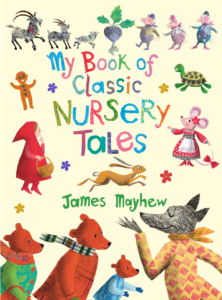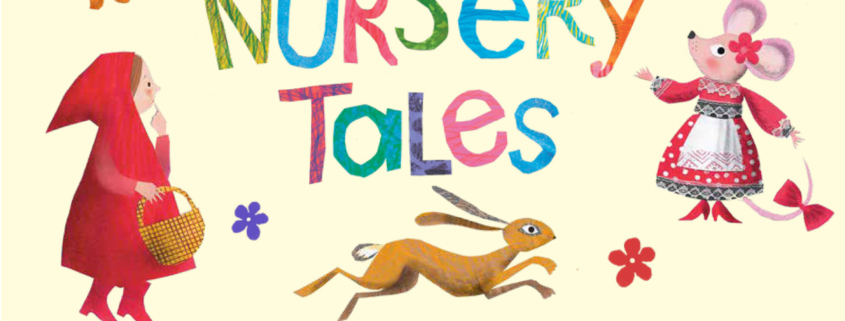My Book of Classic Nursery Tales by James Mayhew
Many of us will have grown up with familiar tales and nursery rhymes. James Mayhew shares his insights into the importance of storytelling and voice but also in sharing these tales from childhood.

Like so many children, I grew up with traditional folk tales, in particular the Ladybird series of “Well-Loved Tales”, and they have stayed with me all my life. Deeply rooted in our cultural heritage, I’m sure I’m not the only person who cannot cross a wooden bridge without thinking of trolls, or explore deep dark forests without looking over my shoulder for big bad wolves. When stories lend themselves to play, imagination, and repetition – as these stories do – then the experience becomes rich, layered and life-long. A bowl of porridge, grandma’s glasses, or a simple gingerbread man become linked to our memories of sharing stories, those precious moments spent at bed time, reading with family together, or in class at school. They are per-fect stories for sharing, remembering, repeating, and an important introduction to how stories work with their familiar structure and patterns.
Although many of these stories have been humorously subverted, with tales of a gun-toting Red Riding Hood (Roald Dahl) or a Pig Bad Pig (Eugene Trivizas), it is important, I think, to preserve and celebrate the original tales, too; without them, children cannot appreciate the humour of any reinterpretation, or understand references in conversation. I also believe that they still stand as great stories in their own right.
I’ve now retold eight traditional ‘Nursery Tales’ and illustrated them for Otter-Barry books, and it’s been wonderful to go back in time and revisit old favourites, and to explore the many variations and complicated sources. I wanted to approach the stories with integrity, although at some point I had to let go, and allow my voice to come through. I needed to be a storyteller, and tell them my way. This, surely, is why the stories have survived. Each new voice, with each new generation, makes them freshly minted, and brings them to life again. I have, of course, preserved the popular, established refrains; The Three Little Pigs still live by the hair of their chinny chin chins.
The stories I chose come from many lands. The Enormous Turnip has a Ukrainian setting, in honour of Ivan Franko’s popular version. The Gingerbread Man was first published in America, and although the story most likely travelled with European settlers, it’s been given an American backdrop in my version. Aesop’s Tortoise and the Hare race through a hot, dry Greek landscape, and The Three Bears, which seems to have been written down first by a Canadian, live on the edge of a great snowy pine forest. The Vain Little Mouse (or La Ratita Pre-sumida in Spanish), is perhaps the least familiar, set amongst sunshine and geraniums
Within these tales, there is much which is eccentric, strange and simply unexplained. But even those with darker elements – gingerbread men are eaten, wolves have real teeth – they have a delicious humour, too. In short, they are fun, silly, sometimes moral, sometimes just stories, but all of them entertaining. Even with the most unlikely scenario, one can find a curious sort of child-like logic behind the action. Children just seem to “get” them, and what a great spark for imaginative play they are.
The illustrations, hand-made with textured and painterly collaged images, have kept me happy company for many months, as I’ve imagined wily wolves and kindly bears, naughty girls and gingerbread men, sly foxes and slimy trolls. Now, its time for a new generation of children to dare to go trip trip over the bridge and into deep into the woods… where I hope they will fall in love with these stories, just as I did.
Views expressed do not necessarily reflect those of the Federation.



